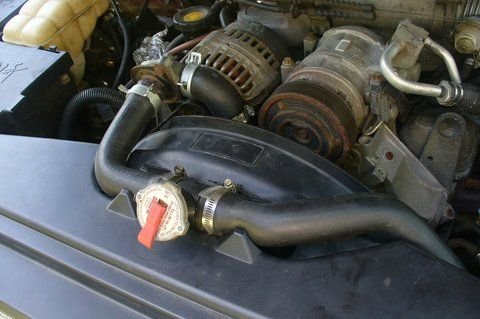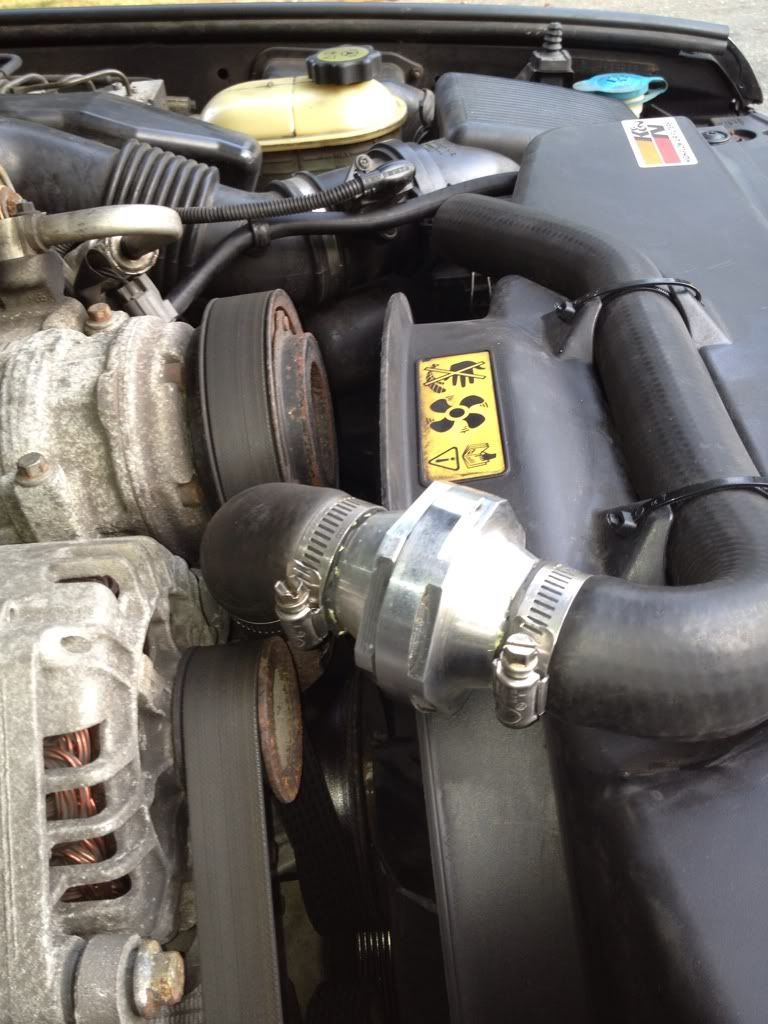Normal stat vs. inline stat
#1
#2
At least that's what I think I get out of it.
#3
Here is my perspective on the issue at hand. Please remember, this is my opinion.
The problem: The OEM cooling system was designed more for passenger comfort than protecting the engine. That is it recirculates hot water back to the engine via the heater and the hose coming from the T hooked up to the water outlet pipe from the manifold. In the process, it allows the all aluminum engine to get too hot and that is where problems arise. Blown head gaskets, slipped liners, etc.
According to renown engine builders(whom have been building reliable Rover engines) claim that these engines make the best hp and reliability with engines at or below 180 degrees and they do not have these problems.
So members(owners of these engines) have experimented with changes to the cooling system.
In my opinion, the minimun change would be to run the OEM 180 thermostat instead of the 195 degree that is factory.
Another option is of course the inline thermostat that more closely resembles the more common cooling system on the majority of other automobile manufacturers.
My problem with the adopted inline modification, that most people use, is the thermostat is too far from the engine. Most engines have the thermostat at the manifold or very close by.
The block can reach dangerous levels before the thermostat opens.
Members have said, just keep your coolant changed and leak free, and 210-220 degrees is ok. Too each his own on that argument, but I refuse to accept that having to replace head gaskets with regularity is normal for any engine.
Don't take my word for it. If you have a google account, you can go to google books and look up "How to build a Rover Engine for road and track". The first chapter is a sample and on the building of the rover blocks. Very enlightening.
The problem: The OEM cooling system was designed more for passenger comfort than protecting the engine. That is it recirculates hot water back to the engine via the heater and the hose coming from the T hooked up to the water outlet pipe from the manifold. In the process, it allows the all aluminum engine to get too hot and that is where problems arise. Blown head gaskets, slipped liners, etc.
According to renown engine builders(whom have been building reliable Rover engines) claim that these engines make the best hp and reliability with engines at or below 180 degrees and they do not have these problems.
So members(owners of these engines) have experimented with changes to the cooling system.
In my opinion, the minimun change would be to run the OEM 180 thermostat instead of the 195 degree that is factory.
Another option is of course the inline thermostat that more closely resembles the more common cooling system on the majority of other automobile manufacturers.
My problem with the adopted inline modification, that most people use, is the thermostat is too far from the engine. Most engines have the thermostat at the manifold or very close by.
The block can reach dangerous levels before the thermostat opens.
Members have said, just keep your coolant changed and leak free, and 210-220 degrees is ok. Too each his own on that argument, but I refuse to accept that having to replace head gaskets with regularity is normal for any engine.
Don't take my word for it. If you have a google account, you can go to google books and look up "How to build a Rover Engine for road and track". The first chapter is a sample and on the building of the rover blocks. Very enlightening.
#4
Here is my perspective on the issue at hand. Please remember, this is my opinion.
The problem: The OEM cooling system was designed more for passenger comfort than protecting the engine. That is it recirculates hot water back to the engine via the heater and the hose coming from the T hooked up to the water outlet pipe from the manifold. In the process, it allows the all aluminum engine to get too hot and that is where problems arise. Blown head gaskets, slipped liners, etc.
According to renown engine builders(whom have been building reliable Rover engines) claim that these engines make the best hp and reliability with engines at or below 180 degrees and they do not have these problems.
So members(owners of these engines) have experimented with changes to the cooling system.
In my opinion, the minimun change would be to run the OEM 180 thermostat instead of the 195 degree that is factory.
Another option is of course the inline thermostat that more closely resembles the more common cooling system on the majority of other automobile manufacturers.
My problem with the adopted inline modification, that most people use, is the thermostat is too far from the engine. Most engines have the thermostat at the manifold or very close by.
The block can reach dangerous levels before the thermostat opens.
Members have said, just keep your coolant changed and leak free, and 210-220 degrees is ok. Too each his own on that argument, but I refuse to accept that having to replace head gaskets with regularity is normal for any engine.
Don't take my word for it. If you have a google account, you can go to google books and look up "How to build a Rover Engine for road and track". The first chapter is a sample and on the building of the rover blocks. Very enlightening.
The problem: The OEM cooling system was designed more for passenger comfort than protecting the engine. That is it recirculates hot water back to the engine via the heater and the hose coming from the T hooked up to the water outlet pipe from the manifold. In the process, it allows the all aluminum engine to get too hot and that is where problems arise. Blown head gaskets, slipped liners, etc.
According to renown engine builders(whom have been building reliable Rover engines) claim that these engines make the best hp and reliability with engines at or below 180 degrees and they do not have these problems.
So members(owners of these engines) have experimented with changes to the cooling system.
In my opinion, the minimun change would be to run the OEM 180 thermostat instead of the 195 degree that is factory.
Another option is of course the inline thermostat that more closely resembles the more common cooling system on the majority of other automobile manufacturers.
My problem with the adopted inline modification, that most people use, is the thermostat is too far from the engine. Most engines have the thermostat at the manifold or very close by.
The block can reach dangerous levels before the thermostat opens.
Members have said, just keep your coolant changed and leak free, and 210-220 degrees is ok. Too each his own on that argument, but I refuse to accept that having to replace head gaskets with regularity is normal for any engine.
Don't take my word for it. If you have a google account, you can go to google books and look up "How to build a Rover Engine for road and track". The first chapter is a sample and on the building of the rover blocks. Very enlightening.
After I posted it occurred to me that the inline thermostat is at the top of the radiator. The return. The stock setup is on the bottom hoses by he water pump where water exits the engine before it enters the radiator.
I will say that mine with the inline setup rarely tops 192 degrees, with a 180 degree thermostat. But the temperature sender is at the top of the manifold, meaning that it is on the return side as well. Food for thought.
Very thoughtful post, Joe.
#5
#6
Then the problem is that the temperature has to reach thermostat at the top hose? I may still be fuzzy thinking but it seems that the best location for the thermostat would be as close to the top of the block as possible, no? I'll re review your post.
Edit... Okay I see you and I are talking about having the thermostat as close as possible, but I'm referring to the place where the hose arches over the alternator by the upper intake manifold. When you say manifold are you talking about the intake or where?
If the intake manifold I saw a great, cheap mod that puts a 90 degree turn and the thermostat right there, and if I can find it I'll post a link. I remember thinking it was a great idea but I'd already done mine.
To the OP I don't mean to hijack your thread but Joe is very knowledgeable and you might be able to avoid the mistake I made with his advice... Which I will ferret out. Haha.
Last edited by Charlie_V; 03-12-2016 at 10:17 PM.
#7
#8
My thinking was get the D1 outlet pipe and do a retro fit, but the D1 used a 2 bolt outlet and the D2 uses a 3 bolt design.
Now I know there are 3 bolt thermostat housings available, but would have to take a manifold to the auto parts house and match one up. And I do not have one to measure or check it out. If I could find a housing to match up to the 3 bolt outlet, that is where I would install the thermostat. I do know when installing this way, the small hole in the thermostat is supposed to be at 12:00 position to allow air to escape to the top hose for bleeding.(as per manual).
If any of you have a lower manifold, and can find a housing to match up, please post.
My other thought was to cut the outlet pipe close to the manifold and install the inline housing at that point, then pipe it to the radiator.
#9
#10
My biggest concern with the stock bypass setup is the wild temperature swings/fluctuations associated with the design. This has raised flags with many others too, as the 180 stock Tstat will give you idle and highway temps in the high 180-to-high 190s range but will see temps spike to 200-something in 2 seconds when the driving condition changes. I have 194 on the highway but when I exit, make one block and stop in my parking spot at home it's 201-203. Inline setup is supposed to eliminate this as well. if everyone on this site did the inline mod, Atlantic-Brit head-gasket kit price would drop over $100 due to surplus in stock. Until owners get the operating temps to 200F or less, a lot of people will continue to needlessly profit from our laziness and ignorance because we have all been made aware on a regular basis here. Not to mention, the swap can be done in the same time and same price for the factory 180 upgrade.
Last edited by chubbs878; 03-13-2016 at 01:00 AM.




